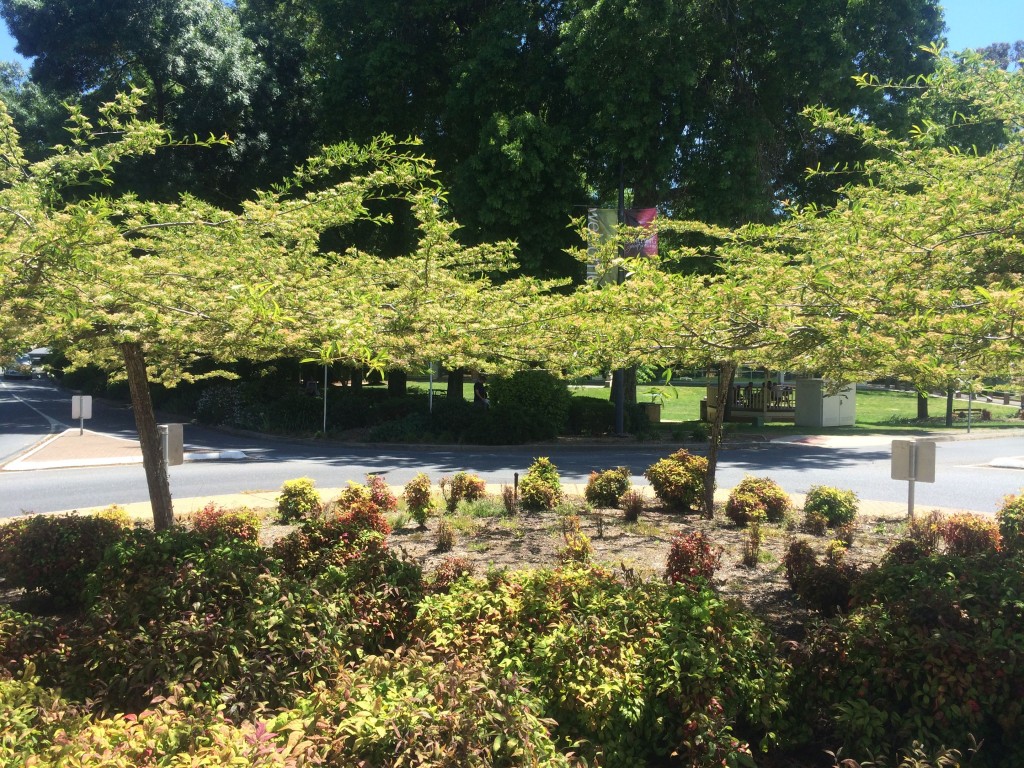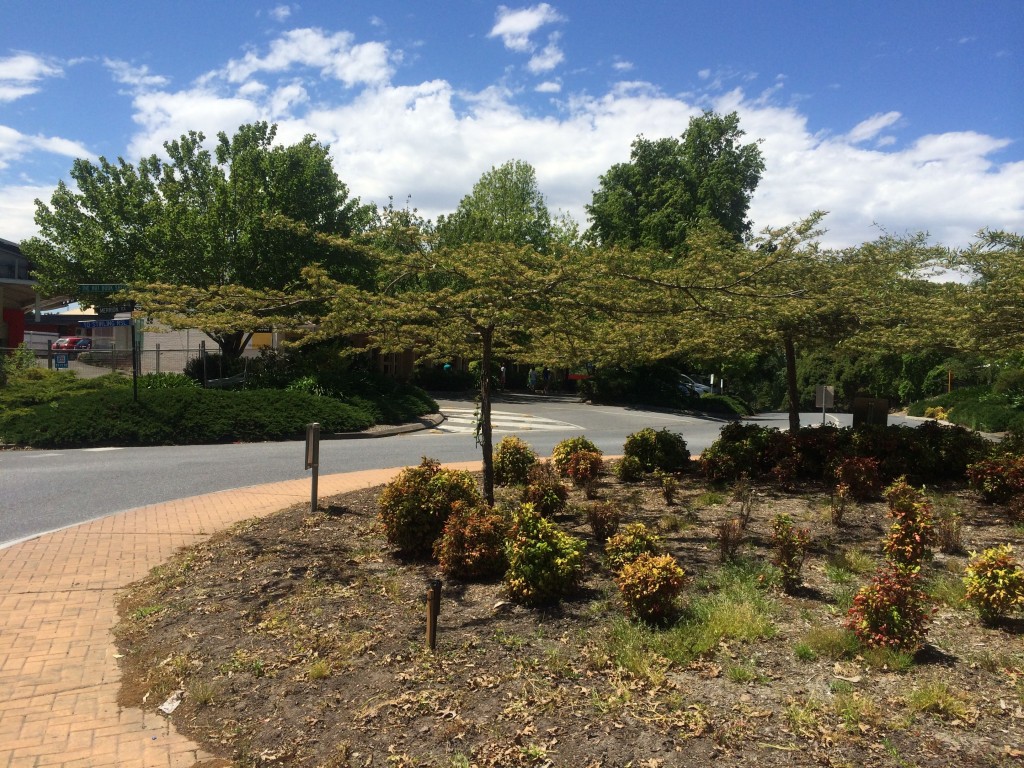Just on a quick dash to the Adelaide Hills for a wedding today, and driving through Stirling this morning, there was an audible gasp from the drivers seat as this roundabout came into view. Couldn’t work out what I was looking at – what plant created this hovering laminar effect, about 1.5 above ground.
Closer inspection revealed an obviously grafted, outrageously horizontal form of hawthorn. Questions immediately bubble up: where do you get this wonderful thing? How does it survive windy days, with that degree of reach? Is it pruned occasionally, or does it naturally form this super-fine, dead-horizontal plateau of foliage? I touched on this plant form in an earlier post, but had never seen anything quite this fine.
Ten days later…
The moment has kind of passed. I tried to post at the time but couldn’t work out how to attach pics from this new iPhone of mine. But that has at least given time for me to work out that I think what we’re looking at is Crataegus crus-galli var. pyrancathifolia. Can someone please confirm or correct this?
A further observation – I was so excited about this wafer-thin plate of suspended foliage that it wasn’t until I was taking pics that I noticed – through the lens – how bad the underplanting was. I can’t stand that dwarf nandina (Nandina domestica ‘Nana’). I hate the way its leaves curl, and I’ve yet to see it used in such a way that its screaming red tones (in cooler weather) are turned to advantage. Of course, I wouldn’t be so stupid to say that it can’t be done. Clients of mine so frequently prove me wrong when I say something can’t be done that I’ve started to wonder if my conviction actually releases the contradictory power.
Furthermore, now there’s the excellent (or so it would seem, on my early acquaintance with it) Nandina domestica ‘Gulf Stream’ (syn ‘Moon Bay’), which just looks like a low growing form of the tall Nandina domestica, why would you use the buckled/warped ‘Nana’?
Having said that, I wouldn’t have used either en masse under here. Neither would remain faintly interesting in that scale of planting, without contrast.



I too have never seen Nandina ‘Nana’ used in a pleasing way. However I love using Nandina ‘Moon Bay’ and what a different effect it has to its dwarf cousin. I spend my time suggesting Moon Bay to clients then having to quickly back up the idea with “oh no, no! I don’t mean the McDonalds car park Nandina!”
For the first time I think maybe a change of plant names (for ‘Moon Bay’) may be of some benefit!
At best (when well grown, and of moderate density), I absolutely love the normal Nandina. At worst (thin and straggly), I can’t stand it. But either way, its whole beauty lies in the super-slender pedicels (actually that won’t be the correct term, as they’re leaflets, not leaves that are being held aloft) holding the leaflets out horizontally, achieving both strength and delicate tenuousness at the same time. If there’s berries, all the better. Apparently the named form ‘Richmond’ is the most reliable at providing these.
Nandina domestica ‘Nana’ achieves the extraordinary in not possessing a single quality of its taller predecessor.
Nandina ‘Moon Bay’ (as it’s mostly sold in Australia, but the RHS Plantfinder doesn’t acknowledge this name, using ‘Gulf Stream’ instead) at least has the same foliage quality as its parent. Glad to hear an experienced vote in its favour
A reader has written to say that Eversen nurseries have stocks of the Crataegus. I’ve just checked the website at http://www.eversen-nurseries.com.au/, and they list Crataegus horizontalis. I might call them and confirm that it’s the same thing. Watch this space
I was unlucky enough to inherit (well, buy a house with) a garden full of Nandina domestica ‘Nana’. I too hate it! The only reason I haven’t removed every last one of them is because I haven’t quite decided what to replace them with in some (out of the way) spots. I keep changing my mind… Seems someone thought they’d be great in full sun, full shade, and in between. I’m so pleased to hear that other much more qualified people share my dislike; sadly far too many people where I live seem to think it’s a wonder!
Ah, the changing of the mind…the curse of options. I face this constantly in my own garden. And in this case (highlighted my Michael Cookes above comment), there’s the added complication of the worthy plant vs the exciting plant
Hmmph. I love Nandina domestica ‘Nana’. It’s a great foliage colour echo for both reds and lime greens. But en masse! Never. And, perversely, I’ve been growing Moon Bay/Gulf Stream for over a year and am unimpressed.
But to return to that wafer thin canopy – wow. I’ve never seen anything like it. Is it really just a natural growth habit? Not pruned at all? But then, once it had all joined up, how could you prune it…..
There aren’t many truly deplorable plants – although for most of my life I thought Nandina domestic `Nana’ was such a thing. Then I used it in a swirling parterre below a row of 5 mop top Robinia in a local nursery, and now I’ve changed my mind.
So tough.
Easy to maintain (none) and sensational colour when the mop tops are dormant…
I like the Crataegus
And when Michael Cooke rethinks and modifies his prejudices over any plant, I feel compelled to give it a second look as well. Thanks for the shake-up!
V much welcome the totally opposing view, Catherine. At least I think I do. Given your reluctance to do anything but whisper your opinions about Great Dixter, maybe I don’t manage to emanate tolerance of diverse opinions as well as I think I do
Could be one reason for your selection as Captain von Trapp……And a swirling parterre of Nandina domestica
‘Nana’ sounds yummo!
Damn! Missed out on tickets! So wanted to heckle during ‘Edelweiss’ – “they’re not white”!
cheers
fermi
Not a chance Fermi. I’d have you weeping like a child with my exquisitely vulnerable rendition of this (rather lame, I reckon) song, and you’d accept, willingly if tearfully, any claim I made as to colour.
Could be the only reason for my selection (coupled with the fact that no one else in the appropriate age group auditioned)
So busted for false modesty Captain Von Trapp. I was on the audition panel…there were at least 3 other strong candidates.
I’d normally insist on verifying such content before approving a comment, but in this case I’ll allow it. The second part may never by verified, but the first is pretty much dead-on. My modesty is – fairly substantially – false.
I have grown Richmond for years and never had a good show of berries. Most disappointing when i have seen other specimens laden with berries. However I am not alone . Having recommended it to several clients they too have complained. I don’t understand the inconsistency.
Surely much of the problem with the underplanting is the arrangement, in a woeful circle with naked soil, even worse sprayed weeds adorning the perimeter! I would have preferred an understorey with a little movement. Dare I say one of the taller growing Lomandra covering the whole area but not planted so close that you can’t see the shape of each plant , that way the wind will tease a little. It is a roundabout after all. Or Maybe one of the lower growing Junipers that will form a lumpy bumpy ground cover.
I wonder if the Crataegus berries?
Dang. I’ve been looking for an opportunity for using large quantities of Nandina ‘Richmond’, given its reliable berrying. If that’s in question, I won’t bother.
As for your alternative ground-covers for this roundabout, the linear cloud of hovering foliage totally dictates the height of the underplanting, doesn’t it? You’d have to ensure at least, say, 800mm of clear space between the strata of foliage in order for the upper one to ‘read’.
Most definitely. As you always say the space is the important volume .
One of my clients has a courtyard framed in the weeping branches of Ulmus parvifolia and an understorey of Nandina. It is gloriously simple and dare I say zen. Another trite saying , a match made in heaven. It is only overuse that makes the plants and the sayings trite, but in context, perfection.
Jim agrees it looks like a Crataegus.
When I first spotted it, I immediately thought Crataegus (from a distance), then from a close-up view of the foliage thought Pyrancantha. It was then pretty convenient to stumble across a crataegus with a varietal name of pyranthafolia. Both boxes ticked.
That could cause an accident! Amazing looking plant. It would look great with red haws, if it fruits. But as you say, the underplanting is rubbish. Hard to understand when presumably the hawthorns weren’t cheap. Or maybe that’s the reason, and the whole budget was spent on the standard plants! I hate Nandina domestica ‘Nana’ for a different reason – everyone says it’s so easy to grow, but it won’t grow for me – just sits there like a lump and then gradually dies.
Hi Michael, talking of stumbling on stuff, I’ve stumbled on your blog! I’m no garden designer, but I am a gardener and your posts make for interesting reading. The comments are interesting too. I also inherited a garden full of the despised Nana and also horrible, horrible Golden Diosma, can you imagine? Fortunately, there was some decent trees planted as well.
Glad you stumbled on The Gardenist. If you look back through some old posts, you’ll find one in which we tried to tease out the inherent repulsion of the golden diosma. We didn’t manage it, but it was an interesting discussion
As a latecomer to this discussion about Nandinas, I just wanted to add a great feature they possess! I’m a dog breeder (& trainer) and lots of people think you can’t have multiple big dogs AND a nice garden..! But it is possible..as I have one..just requires extra effort both with a plantings & with training! One of Nandina’s significant virtues for me is that it survives being widdled on by male dogs! So it is a good hedging option, where co-existence with medium size to larger (male) dogs also roam! I have tried a vast array of other common hedge plants but they have all succumbed when regularly wee-ed on..! – except Nandina..!
Moon Bay comes into its own after a few years, as an attractive dwarf version of the tall variety. Clips beautifully..
Have yet to resolve female dogs causing burn spots in the lawns! ????
As a latecomer to this discussion about Nandinas, I just wanted to add a great feature they possess! I’m a dog breeder (& trainer) and lots of people think you can’t have multiple big dogs AND a nice garden..! But it is possible..as I have one..just requires extra effort both with a plantings & with training! One of Nandina’s significant virtues for me is that it survives being widdled on by male dogs! So it is a good hedging option, where co-existence with medium size to larger (male) dogs also roam! I have tried a vast array of other common hedge plants but they have all succumbed when regularly wee-ed on..! – except Nandina..!
Moon Bay comes into its own after a few years, as an attractive dwarf version of the tall variety. Clips beautifully..
Have yet to resolve female dogs causing burn spots in the lawns! ????
Thanks for that info, Merry. It’s great to know what plants are capable of surviving such treatment.
Here in Australia Nandina ‘Moon Bay’ and ‘Gulf Stream’ are one and the same. Low maintenance, and year round color is an advantage.